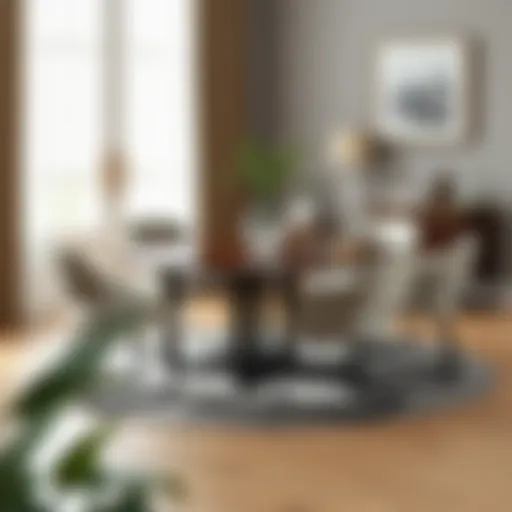Discovering the Versatility of Fabric Chaises for Interiors
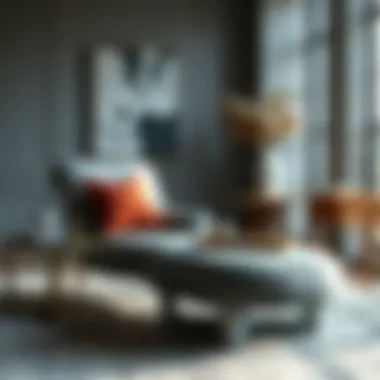

Intro
Fabric chaises serve as versatile furniture pieces that seamlessly blend practicality with a touch of elegance. As many homeowners seek to maximize their living spaces, the appeal of fabric chaises grows stronger. From enhancing the aesthetic charm of a room to offering a cozy nook for relaxation, fabric chaises are more than just stylish additions; they represent a functional element that can adapt to various styles and preferences. This guide will explore the intricacies surrounding fabric chaises, including a deep dive into design trends, care strategies, and insightful considerations for selecting the perfect chaise for any space.
Furniture Styles and Trends
Modern vs. Traditional: Understanding the Aesthetics
When stepping into the realm of fabric chaises, one finds themselves amidst a spectrum of styles, from traditional craftsmanship to modern minimalism. Traditional chaises often feature ornate legs and intricate fabric patterns, invoking a timeless vibe that speaks of history and heritage. Picture a Victorian-era lounge adorned with rich velvet upholstery, inviting guests to sink into its embrace like a warm hug.
In contrast, modern fabric chaises tend to lean towards simplicity, focusing on clean lines and neutral colors. Think about those trendy mid-century designs with soft, muted fabric in shades like taupe or icy blue, making a striking statement without drowning the room in chaos. The juxtaposition of these styles allows homeowners to express individuality based on personal taste.
"Choosing the right chaise can transform your space into a reflection of your personality."
Color and Material Trends: What's In and What's Out
Color plays a critical role in the overall design of a fabric chaise. Currently, earthy tones such as terracotta and sage greens are taking center stage, providing a warm atmosphere reminiscent of nature. On the flip side, bold colors like deep navy or mustard yellow often act as statement pieces, energizing a space with vibrancy.
Materials also hold their own significance. Natural fabrics like linen and cotton breathe better and are quite suitable for casual settings. Meanwhile, synthetic materials have improved tremendously, offering durability without sacrificing style. It's essential to gauge the lifestyle needs against these options, as families with pets or children might find sturdier materials more appealing.
Furniture Care and Maintenance
Tips for Prolonging the Life of Your Furniture
To enhance the longevity of fabric chaises, homeowners should incorporate a few simple maintenance practices:
- Regular Vacuuming: Dust and debris can accumulate quickly. Regular vacuuming helps maintain fabric integrity.
- Avoid Direct Sunlight: UV rays can lead to fading. Position your chaise away from windows where the sun shines directly.
- Spot Clean Spills Quickly: Address spills immediately with mild soap and water. Test in an inconspicuous area first to avoid unwanted damage.
DIY Repair Hacks for Common Furniture Issues
Sometimes, no matter how careful you are, wear and tear happen. For those who prefer a hands-on approach, there are DIY solutions available for common issues:
- Patching Small Scratches: Use a fabric patch or a no-sew fabric adhesive to cover small scratches or holes.
- Cleaning Stains: For persistent stains, try mixing equal parts vinegar and water in a spray bottle. Blot, don’t rub, the stain for a better outcome.
- Re-stuffing Cushions: If cushions lose their shape, consider adding extra stuffing or batting to revive them without needing to replace the whole chaise.
The art of integrating fabric chaises into a home is all about understanding their potential and the effort required for upkeep. With growing awareness of design and care, fabric chaises can beautifully shine in modern interiors, offering both functionality and style.
Prologue to Fabric Chaises
Fabric chaises hold a unique position in home furnishings, combining the essence of style and comfort in a single piece. These versatile seating arrangements not only serve as a functional element but also make a statement about the owner’s taste and lifestyle. Particularly relevant for homeowners and designers alike, fabric chaises can transform an ordinary space into an inviting oasis.
The benefits of incorporating fabric chaises into your living area are manifold. For starters, they offer an inviting space for relaxation, be it for reading, reclining, or socializing. Additionally, choosing the right fabric and design can enhance the overall aesthetic of a room, aligning seamlessly with personal decor styles. It’s worth noting that the array of choices available in terms of color, pattern, and material makes fabric chaises an appealing option for almost every setting.
Considerations around placement and functionality further highlight their significance. A carefully selected chaise can optimize the layout of a room, making efficient use of available space. It draws attention while providing comfort, serving as both a decorative and practical asset.
"A well-chosen fabric chaise can redefine the energy of a room, acting as a focal point that resonates with your decor style."
Definition and Characteristics
At its core, a fabric chaise is an elongated chair designed for reclining, often equipped with an armrest on one side. Its name originates from the French word for "long chair," and the silhouette typically spans the length of the body, allowing for an array of lounging positions. Characteristically, fabric chaises can vary significantly in their design—from classic styles, which boast intricate detailing and vintage aesthetics to modern forms that emphasize clean lines and minimalist appeal.
What sets fabric chaises apart is the material used. Fabrics range from luxurious velvets and soft chenilles to easy-care cotton blends, catering to diverse tastes and practical needs. Additionally, the frame construction is equally pivotal in determining durability and comfort. Solid wood frames provide both stability and a touch of elegance, whereas metal or synthetic frames can lend a contemporary edge.
Historical Context
The history of fabric chaises is rich and colorful, tracing back to the ancient civilizations where relaxed seating was valued. It saw significant evolution during the 18th century, when Europe experienced a rise in luxury and leisure furniture, particularly among the elite. Chaises became an essential part of salons, used during social gatherings. They were often ornately crafted, reflecting the artistic movements of the time, such as Rococo or Neoclassicism.
As time progressed, adaptability transformed the chaise’s role, especially throughout the 19th and 20th centuries. Influenced by movements like Arts and Crafts, and later the Mid-century modern style, the chaise became more accessible and versatile. Today, it encompasses a wide array of looks and features, solidifying its status as a staple in contemporary interiors. Whether high-backed or sleek, elaborate or simple, fabric chaises continue to express the evolving narratives of design while providing comfort and functionality.
Types of Fabric Chaises
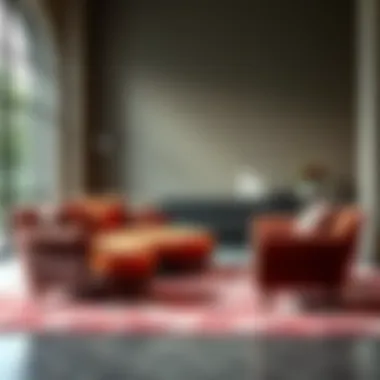

Understanding the different types of fabric chaises is crucial in making informed decisions for any living space. This diversity reflects not just aesthetic preferences but also enhances functionality and adaptability to various environments. Each type serves distinct purposes, appealing to varied tastes and practical needs.
Traditional Styles
Traditional chaises often embody classic lines, rich fabrics, and ornate details. These styles commonly evoke a sense of history and heritage, frequently drawing inspiration from various artistic movements. Think Victorian elegance or Baroque splendor, where craftsmanship takes center stage. You might find these pieces embellished with tufting, intricate carvings, or even fringed edges.
To select a traditional fabric chaise, consider:
- Materials: Luxurious options like velvet or damask cater to bringing in an air of sophistication.
- Color Palette: Deep colors like burgundy or forest green can create a warm, inviting atmosphere.
- Placement: These pieces often serve as focal points in a room, so position them in spots that allow for showcasing their beauty.
Overall, traditional chaises are not just furniture; they become conversation starters, inviting admiration from guests while seamlessly integrating into historical or formal settings.
Contemporary Designs
Contemporary fabric chaises break from ornate traditions to embrace clean lines and functional design. This style is all about simplicity and innovation. Designers play with bold shapes and vibrant patterns, often using materials that reflect modern sensibilities. Fabrics such as microfiber and leather alternatives often take center stage.
Essential considerations when opting for a contemporary chaise include:
- Versatility: The minimalist design often fits well in various settings, from urban apartments to cozy homes.
- Functionality: Many come with added features like reclining options or built-in storage, maximizing their utility.
- Color and Pattern: Bright colors and geometric patterns can energize a space, making it feel fresher.
In a contemporary environment, a well-chosen chaise can accentuate the design while exuding a relaxed, yet sophisticated, vibe.
Custom and Bespoke Options
For those seeking unique flair, custom and bespoke fabric chaises present an avenue for personalization. Individuals can tailor various aspects of these chaises, including size, style, and fabric, to match their specific needs and tastes. This often involves collaborating with designers or craftsmen to create something truly one-of-a-kind.
Key advantages of custom chaises include:
- Personalization: Choose every element from cushion firmness to armrest shapes, ensuring it fits perfectly in your space.
- Quality: Often made with higher-quality materials, these pieces can offer durability and comfort tailored to your specifications.
- Design Harmony: Custom options can be design-matched with existing decor, creating a cohesive aesthetic throughout the space.
In today’s market, the value of bespoke design cannot be overstated; it transforms a simple piece of furniture into a statement of individuality and style.
Investing in the right type of fabric chaise can significantly influence the ambiance of a room. Consider not just the visual aspect, but also how these furnishings contribute to the functionality of your space.
Design Considerations for Fabric Chaises
When it comes to incorporating a fabric chaise into your living space, design considerations aren't just optional; they are paramount. Far more than merely an aesthetic addition, the thoughtful selection of elements like color, shape, and pattern enhances functionality and overall appeal. Through careful consideration, homeowners and designers can maximize the potential of these versatile pieces, ensuring they blend seamlessly into their intended environments.
Color and Pattern Selection
The choice of color and pattern can drastically alter the atmosphere of a room. Consider selecting hues that either complement or contrast your existing decor, giving you the opportunity to create a stunning focal point. For instance, neutral tones such as beige or grey serve well in more traditional settings or when aiming for understated elegance. On the other hand, bold patterns like floral or geometric prints can inject vibrancy, allowing the chaise to stand out and act as a conversation starter.
When selecting fabric, think about how color trends evolve over time. Perhaps opting for timeless shades allows for longevity, while seasonal trends can be implemented through cushion covers or throws. A rule of thumb many like to follow is the 60-30-10 rule of color, using 60% of a dominant color, 30% of a secondary color, and 10% for accent tones. This method works well for ensuring a balanced aesthetic.
"The right color can evoke emotions and set a tone that creates an ambiance in the room."
Shape and Size Preferences
Shape and size preferences play a significant role in how well a fabric chaise fits into a room’s layout. From classic curved forms to angular modern designs, the shape impacts the overall feel of the space. A curvy chaise might lend itself nicely to a room aimed at warmth and approachability, while a sleek rectangular chaise can convey a more contemporary vibe.
For size, it's crucial to consider the dimensions of your space. A large, oversized chaise can overwhelm a compact room, while a petite design might get lost in a spacious setting. Always measure the surrounding area to ensure that the chaise leaves enough room for movement and doesn’t obstruct sightlines. Since many people enjoy their chaises for relaxing or napping, evaluating comfort alongside proportions can drastically enhance usability.
Integration with Existing Decor
Another critical factor to consider is how your fabric chaise integrates with existing decor. The aim is to create a cohesive environment where the chaise adds to the overall style rather than standing out discordantly. Begin by evaluating your current furniture and color scheme. Do your living room’s wood tones harmonize with the fabric? Are the textures complementary?
Incorporating elements like pillows or throws in matching fabrics can create a unified look. You might even find inspiration in pieces of art or wall colors. One practical approach to blending the chaise into the existing decor is by choosing a fabric that echoes other surfaces in the room—be it your curtains, rug, or even wall colors.
Consideration for high-traffic areas is also essential when integrating fabric chaises. This will determine not only the choice of fabric—opt for more durable materials—but also the design; are there pets or children? These questions help in selecting a chaise that not only fits in style but also stands the test of time.
In summary, attentive planning regarding color and pattern, shape preferences, and integration into existing decor will ensure your fabric chaise is not just another piece of furniture but a vital enhancement in your space.
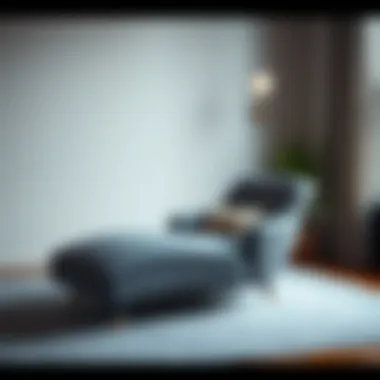

Materials Used in Fabric Chaises
The choice of materials in fabric chaises is paramount, as it influences not only the aesthetic and comfort level but also the durability and maintenance needs of these furniture pieces. Understanding the different materials helps homeowners and designers make informed decisions that enhance the living space while also catering to functionality. The materials selected can significantly impact how a chaise complements the surrounding decor, aligns with personal style, and meets everyday durability demands.
Natural Fibers
Natural fibers have a charm and appeal that synthetic fabrics often struggle to replicate. Materials such as cotton, linen, and wool are frequently used in fabric chaises due to their breathable characteristics and soft textures. With cotton, for instance, you get a fabric that feels good against the skin, making it a popular choice for those who enjoy lounging for extended periods. Linen, on the other hand, offers a relaxed, wrinkled look that adds a touch of sophistication, even in casual settings.
Advantages of Natural Fibers
- Breathability: This keeps you comfortable, especially in warmer climates.
- Sustainability: Many natural fibers are grown without the use of harmful chemicals, making them environmentally friendly.
- Aesthetic diversity: Comes in a wide range of colours and patterns, making them suitable for various style preferences.
However, it’s important to keep in mind that natural fibers can be susceptible to staining and fading. Regular maintenance is key if you want to keep that fresh look. Plus, some might require special cleaning methods to maintain their integrity.
Synthetic Fabrics
Synthetic fabrics like polyester, acrylic, and nylon have carved a niche for themselves in the realm of fabric chaises. These materials are engineered for durability and ease of cleaning, making them a hit for families or those with pets. Polyester, for instance, mimics the look of natural fabrics while providing greater stain resistance and toughness.
Benefits of Synthetic Fabrics
- Durability: These fabrics often withstand more wear and tear compared to their natural counterparts.
- Stain resistance: Many synthetic fabrics can be easily wiped cleaned, which is a boon for busy households.
- Affordability: Generally, synthetic options can offer a more budget-friendly choice compared to some natural fibers.
That said, they may lack the breathability found in natural fibers, which can be a drawback in warm environments. Some individuals might also find them less pleasing to touch than the softness of cotton or wool.
Comparative Durability and Care
When discussing the durability of fabric chaises, it’s essential to weigh the pros and cons of both natural and synthetic options. Each material comes with its own set of maintenance requirements.
- Natural Fibers: Regular vacuuming and occasional professional cleaning can help maintain these fabrics' appearance. They can also be treated with fabric protectors to enhance their resistance to stains and spills.
- Synthetic Fabrics: These typically require simple cleaning procedures. Many can be cleaned with water and mild soap, ensuring that they stay looking fresh without the need for specialists.
In the quest for a long-lasting fabric chaise, understanding the relationship between material choice and care routines is vital. Selecting the right fabric can save you time and money in the long run.
Ultimately, the choice between natural and synthetic materials for fabric chaises hinges on personal preferences, lifestyle needs, and design aspirations. Thus, weighing these attributes is essential to find the perfect fit for your space.
Functional Benefits of Fabric Chaises
Fabric chaises offer a range of functional benefits that elevate them beyond mere furniture pieces, making them a valuable addition to any home. Considering their role in design and comfort, these chaises come with practical advantages that cater to diverse lifestyle needs. Whether you're a homeowner looking to maximize space or a designer focused on user experience, understanding these benefits is crucial for making informed choices about fabric chaises.
Comfort and Usability
One of the foremost benefits of fabric chaises is the comfort they offer. Unlike traditional chairs, a chaise allows you to recline while maintaining an upright posture. This positioning provides excellent lumbar support, crucial for anyone who spends extended hours relaxing or reading. The softness of the fabric also contributes significantly to comfort; a micro-suede finish, for instance, feels luxurious against the skin, improving the overall sitting experience.
- Versatile Seating Options: They can accommodate a range of activities, from lounging with a book to watching television.
- Personalized Comfort: Options for varying cushion firmness mean users can choose a level that particular suits their preferences.
"The right chaise can be like hugging a cloud, yet supporting your back just right."
When selecting a fabric chaise, it's important to consider your personal comfort needs. Not every fabric performs the same. For example, leather might offer sleek aesthetics but can get hot in summer months, while breathable fabrics can provide year-round usability.
Space Optimization
Chaises excel in space optimization, making them particularly beneficial in smaller homes or apartments. They serve as a compact alternative to bulky sofas, maximizing seating area without overwhelming a room. This spatial efficiency allows homeowners to keep their spaces airy and open, essential in today's design philosophy that favors minimalism.
- Multi-Functional Use: Chaises can serve dual purposes, from a seating area to additional sleeping space for unexpected guests.
- Placement Flexibility: They can be placed against a wall or in a corner, contributing to efficient space usage.
The sleek profile often found in fabric chaises means they can slide into places where a sofa might not fit, enabling any corner or nook of the home to serve a purpose—be it in a sunroom, living room, or even a home office.
Multi-use Applications
Fabric chaises are not only practical but also versatile in their applications. They can serve numerous functions in both residential and commercial spaces. Think about how this furniture can adapt to various settings:
- Living Spaces: Perfect for reading nooks or as a statement piece in a well-decorated room.
- Office Use: They can be used in waiting areas or informal meeting spaces, offering visitors an inviting place to rest.
- Guest Rooms: In small homes, a chaise can be a stylish alternative to a guest bed, providing comfort without compromising on decor.
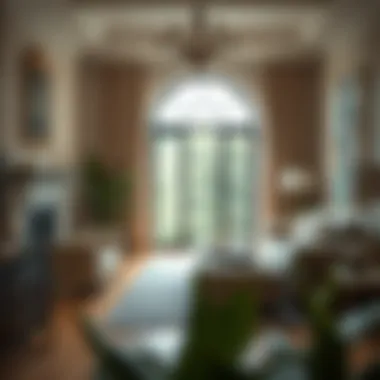

The adaptability of fabric chaises is further enhanced by their availability in diverse styles and colors. Homeowners can select one that complements existing decor or goes all out with something more vibrant to create a statement.
Current Trends in Fabric Chaises
As we glance at the landscape of interior design, fabric chaises have taken center stage. Beyond their role as mere seating options, they now embody trends that align with societal shifts, sustainable values, and technological advancements. Keeping an eye on current trends is essential for homeowners, designers, and connoisseurs of fine furniture, as these trends not only reflect aesthetic preferences but also practical solutions that cater to modern living environments.
Sustainable Practices
One of the most significant trends within the realm of fabric chaises is the sustainable practices gaining traction in the design and manufacturing processes. In light of increasing environmental awareness, many consumers seek out furniture that meets both ethical standards and functional requirements. This shift is crucial for several reasons:
- Reduced Carbon Footprint: Manufacturers are now sourcing materials that are eco-friendly and require less energy for production. For example, organic cotton and responsibly harvested wood are becoming common materials used in fabric chaise construction.
- Longevity and Durability: Emphasizing durability over disposability helps in creating furniture that lasts. By investing in high-quality materials and craftsmanship, consumers reduce the need for frequent replacements, which in turn lessens waste.
- Recycling and Upcycling: Many designers are turning to recycled materials to create innovative chaise styles. This not only minimizes waste but also gives a unique character to each piece.
Ultimately, integrating sustainable practices into the design of fabric chaises not only meets consumer demand but also contributes positively to the planet's health.
Smart Fabric Technologies
As technology creeps deeper into our homes, smart fabric technologies have emerged as a remarkable trend in fabric chaises. The allure of combining comfort with cutting-edge technology is undeniable. Key features of smart fabric technologies include:
- Stain Resistance: Advancements in textile technology have produced fabrics that resist stains, making maintenance a breeze. This is particularly advantageous for households with pets or children.
- Temperature Regulation: Certain smart fabrics are designed to adapt to body temperature, ensuring a comfortable experience year-round. Imagine a fabric chaise that keeps you cool in the summer and warms in the winters.
- Integrated Charging Stations: With the rise of smart devices, some modern chaises are coming equipped with built-in USB ports or wireless charging capabilities, allowing homeowners to recharge their devices with ease.
"Smart technology in fabric chaises not only enhances user experience but also highlights the evolving relationship between comfort and innovation in our living spaces."
By staying informed about these current trends, individuals can make well-informed decisions about fabric chaises that not only elevate their living spaces but also mirror their values and lifestyles. Ignoring these trends could mean missing out on the opportunity to create a home that is not just stylish, but also embraces the future.
Care and Maintenance of Fabric Chaises
Taking care of fabric chaises might seem like a minor detail in the grand scheme of home decor, but it’s anything but insignificant. Regular maintenance not only prolongs the life of these stylish furniture pieces, but it also ensures they remain a focal point in your living space rather than an eyesore. By investing time in proper care, you can keep your chaise looking fresh and inviting, thus enhancing the overall ambience of your home.
Regular Cleaning Techniques
A successful cleaning regime for fabric chaises hinges on a consistent approach. Regular upkeep can prevent dirt and grime build-up, making deep cleaning easier down the line. Here’s how to tackle cleaning head-on:
- Vacuuming: Use a soft brush attachment to vacuum your chaise weekly; this helps remove dust and loose particles without damaging the fabric. Pay attention to seams and crevices.
- Spot Cleaning: Use a damp microfiber cloth to gently dab stains. Avoid scrubbing, as it may push the dirt further into the fabric.
- Steam Cleaning: For a deeper clean, steam can be an effective method. Make sure the fabric can withstand this treatment by checking the care label.
These techniques can become a part of your regular home maintenance schedule, keeping your fabric chaise in top shape with minimal effort.
Dealing with Stains
Stains are the nemesis of any chaise, but knowing how to handle them can save you a heap of trouble. The key is to act fast:
- Identify the Stain Type: Different stains require specific treatments. For instance:
- Homemade Solutions: Most of the time, you can concoct a solution with materials already at home. A mix of mild dish soap and water can work wonders for many fabric types.
- Commercial Stain Removers: If DIY methods don’t cut it, choose a stain remover suitable for your chaise’s fabric. Always conduct a patch test first to ensure it won't harm the fabric.
- Liquid Stains: Blot immediately with a cloth. Do not rub!
- Food Stains: Scrape off any residue gently before dealing with the base stain.
"A stitch in time saves nine" - applying quick measures on stains can save your fabric from permanent damage.
Long-term Preservation Strategies
To truly get the most out of your fabric chaise, long-term care must be considered:
- Protective Covers: Consider using a breathable fabric cover when your chaise isn’t in use. This protects it from dust, pet hair, and sunlight.
- Positioning: Avoid placing your chaise in direct sunlight to prevent fading. Its color will remain vibrant if shielded from harsh UV rays.
- Rotation: If your chaise has removable cushions, rotate them regularly. This helps prevent uneven wear and keeps your chaise looking balanced.
Taking these steps allows you to enjoy your fabric chaise for years to come, ensuring it remains a beloved spot in your home. By treating it with care and respect, you are not just preserving a piece of furniture but also nurturing a part of your living space’s identity.
Culmination
In wrapping up our discussion on fabric chaises, it becomes clear that these pieces embody a blend of style and utility that serves well across various living spaces. The great thing about them is their ability to adapt to not just aesthetic preferences but also functional needs. Homeowners, designers, and retailers alike should recognize that a fabric chaise isn't merely a luxurious addition; it's a versatile tool for enhancing comfort and extending the usability of a room.
Summary of Insights
Through this article, we have explored the many dimensions of fabric chaises, touching on their evolution and numerous styles. From traditional designs to contemporary pieces, fabric chaises accommodate a plethora of tastes. Key takeaways include the importance of selecting the right materials, understanding design integration, and keeping maintenance strategies in mind. The fabric and structure not only influence their comfort level but also contribute significantly to a home's overall ambiance.
"A fabric chaise can be the unsung hero of a well-designed space, effortlessly marrying form with function."
Future of Fabric Chaises in Home Design
Looking forward, the trajectory of fabric chaises seems promising, especially considering shifting trends toward sustainability and smart technologies. As homeowners become increasingly environmentally conscious, the demand for chaises constructed from sustainable materials is on the rise. Furthermore, innovative fabrics that resist stains or incorporate smart technology are beginning to redefine what a chaise can be. These advancements will likely push designers to think outside the box, leading to more multifunctional uses that align with modern lifestyle demands. Whether it's a cozy reading nook or a stylish centerpiece in a living room, fabric chaises are set to become increasingly relevant in the world of home design.

